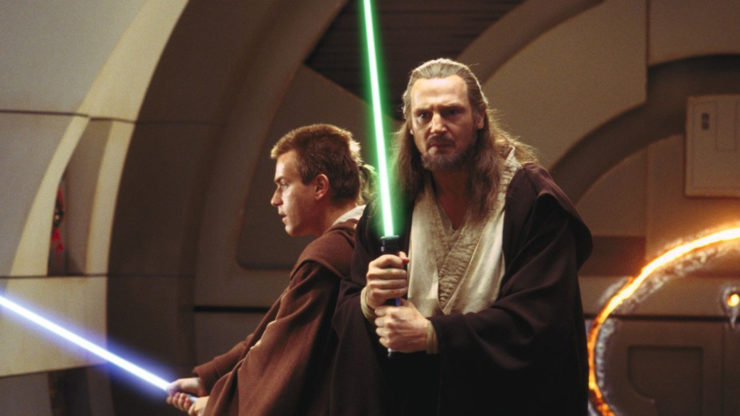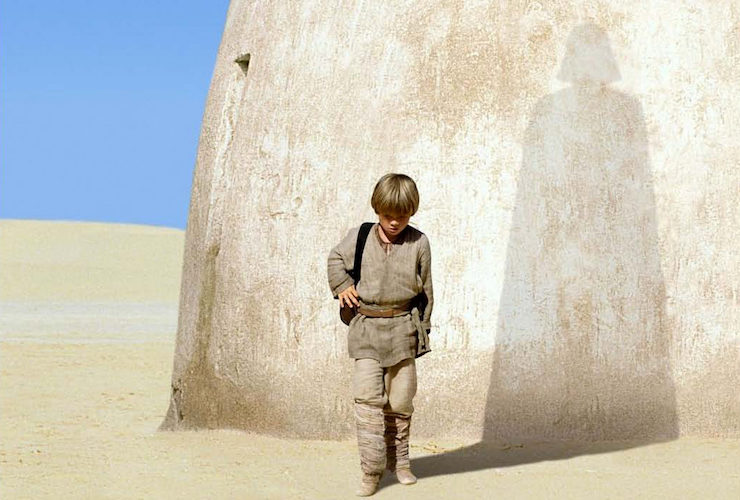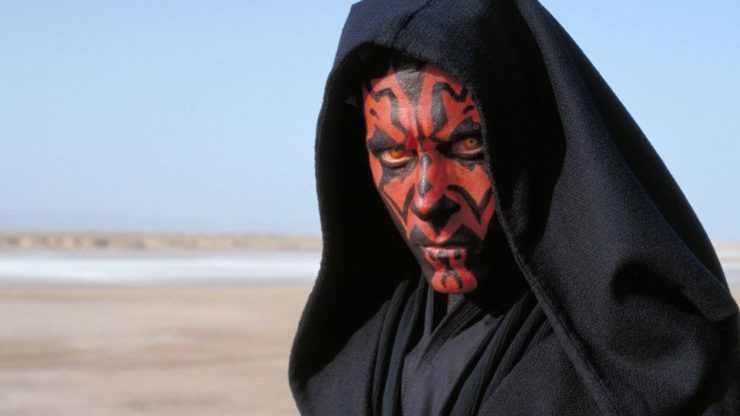Boy oh boy has The Last Jedi stirred up a hornet’s nest.
But, look: I’m not here to discuss that whole thing. Not at the moment, at least. Rather, let’s go back to the halcyon days of Star Was fandom, back to 1999 where there wasn’t all this debating over who was a “real” Star Wars fan or any talk about a single movie ruining the entire franchise.
Oh wait.
Like 2017, 1999 (and beyond) proved to be a contentious year for the Star Wars franchise. On May 19, The Phantom Menace was released in theatres, kicking off the beginning of the prequel trilogy and what can fairly be described as a tumultuous chapter in the Star Wars franchise. Due in part to the growth of the internet, the prequels became the target of rage, mockery, humor, discussion, debate, and pretty much everything in-between. Whether you love or hate these films, there’s no denying that they’ve sparked a tremendous amount of backlash and confusion amongst fans. To this day, Jar Jar is still a punchline. Midichlorians are still a tough pill for many to swallow. And we still don’t know what the hell that orb thingy Boss Nass held up at the film’s conclusion was.
Still, warts and all, I love this movie.
Let me start with a general statement about the prequels on the whole, a truth that contributes to my love for each and every one of these films: In the age of tentpole filmmaking, I contend that there will never be a series of big-budget films as bold, as artistic, or as risky as the prequel trilogy. Look, Lucas could have remixed the original trilogy. He could have easily stuck to the Star Wars playbook, and as we’ve seen with The Force Awakens, he would have found greater success doing so. But he didn’t. Lucas gave us an entire new vision of the galaxy far, far away. New planets, new ships, new characters; it looked different, it felt different, yet somehow—to me, at least—it’s all undeniably Star Wars. And when you stack those movies against similar big-budget franchise films (I love Marvel movies, but good gravy I’ve seen Iron Man like 20 times already, just in different iterations), there’s an undeniable boldness that, love the prequels or hate them, exists in their creation.
I will die on this hill.
That aside, let’s talk about The Phantom Menace. Now, I’m a realist about this movie, and the things it gets criticized for—Jar Jar, midichlorians—are totally justified. But while the film does have its imperfections, the proliferation of those imperfections has worked to bury some of the movie’s more interesting qualities.

Let’s start at the top, where all Star Wars movies start: with the Jedi. Granted, we’d seen plenty of Jedi before, in Luke, Obi-Wan, and Yoda. But we never got an inkling of what the Jedi were like when they were, as Obi-Wan said, guardians of peace and justice in the old Republic. The Phantom Menace pulls back this veil, but in an unexpected way. It’s important that we see the Order through the eyes of Qui-Gon, who, in the tragically short amount of time we spend with him, is shown to possess a bit of a rebellious streak—if not downright defiance—when it comes to following the advice and rules of his fellow Masters. What’s interesting is that the Jedi, one would think, are supposed to be wise beyond reproach, if not altogether infallible. In the first movie, we see Qui-Gon crack this mold; right from the start, we’re shown that the Order isn’t as absolute as we would have assumed, and Lucas’s undermining our expectations is vital. To fully grasp Anakin’s tragic downfall, it’s essential to understand how the Jedi Order, which becomes more and more dysfunctional with every movie, lost its way and failed its duty (in fact, this admission of the Order’s failure is central to The Last Jedi). And it’s one thing for the Order to be questioned by an outsider; but to have one of their own—Qui-Gon—be so defiant shows the discord within their own ranks—discord that will lead to death and dissolution.
This, ultimately, is the cornerstone of the prequel trilogy—how Anakin’s downfall was not only a result of his seduction by the dark side but also the failure of the Jedi. It’s not an equal measure of culpability, but Lucas is clearly painting a more complex picture of the light and the dark and Anakin’s role navigating between both, and that relationship is fully initiated in The Phantom Menace.
Beyond that, the movie possesses several high marks that deserve recognition. For starters, there’s the pod race scene, which is a masterful sequence of filmmaking (and not just for a Star Wars film). If any praise is tossed The Phantom Menace’s way it’s usually aimed at the pod race, but it’s still worth mentioning what a thrilling, tremendous sequence it is. Darth Maul—even though he doesn’t say…well, hardly anything—is still an awesome villain, and the choreography of his fight with Qui-Gon and Obi-Wan is nothing short of brilliant.
Where The Phantom Menace’s success really lies—besides laying the groundwork for exposing the flawed Jedi Order and Anakin’s eventual downfall—is in the way it manages to expand the Star Wars universe. Granted, the original trilogy sent us to amazing planets and there was no shortage of ridiculously cool aliens, bounty hunters, droids, and more. But our scope was pretty much limited to Luke and his cohorts (which is fine—these aren’t my favorite movies for nothing, mind you). The Phantom Menace’s worldbuilding shows us not only rich and unique new worlds—Coruscant and Naboo are amazing—but it also exposes us to new wrinkles in the universe. Like its handling of the flawed Jedi Order, The Phantom Menace introduces us to the galaxy’s equally flawed political system; we see its dysfunction and its disunity, and we start to form a clear picture that informs us how the mighty Republic was able to be corrupted and, eventually, fall. Sure, the political angles—trade routes and all that—can be a little boring at times, a little dry, and a bit too complex. But The Phantom Menace is also responsible for showing how negligence can lead to war, war can lead to betrayal, and all those things combined can lead to the rise of the only evil strong enough to rot the entire galaxy.

In its multilayered approach to forging a new Star Wars story while still retaining pieces of the past, The Phantom Menace strikes a chord that no one anticipated. It wasn’t the rollicking space adventure that most people—myself included—expected; instead, it’s a fascinating, complex story about power, morality, and the seed of corruption that’s planted in The Phantom Menace grows and grows until it consumes not only Anakin but the entire galaxy. Like The Last Jedi, it’s not a typical Star Wars film, and it requires a fair amount of work to come to terms with everything that’s happening in the story. But it’s a worthwhile endeavor to give these complexities a chance and see The Phantom Menace for the nuanced, thrilling, and masterful bit of filmmaking that it is.
 Michael Moreci is a comics writer and novelist best known for his sci-fi trilogy Roche Limit. His debut novel, Black Star Renegades, is available now. Follow him on Twitter @MichaelMoreci.
Michael Moreci is a comics writer and novelist best known for his sci-fi trilogy Roche Limit. His debut novel, Black Star Renegades, is available now. Follow him on Twitter @MichaelMoreci.










